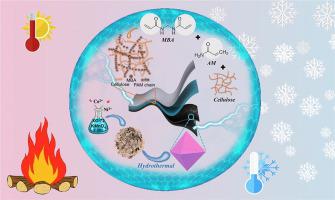Chemical Engineering Journal ( IF 15.1 ) Pub Date : 2021-03-06 , DOI: 10.1016/j.cej.2021.129179 Bin Chen , He Miao , Mingming Yin , Ruigan Hu , Lan Xia , Chunfei Zhang , Jinliang Yuan

|
Flexible quasi-solid-state zinc-air batteries (ZABs) with outstanding power density, charge–discharge efficiency and robustness are extremely desired for wearable electronic devices. Therefore, it is urgent to develop superior bifunctional oxygen catalysts and robust solid-state electrolytes. Mn-based spinels (MMn2O4) attract great attention due to their high abundance, low toxicity and well-balanced activity-stability performances. However, the Mn-based spinels are generally synthesized at high temperature, which usually causes large particle size, low surface area and insufficient active sites, being detrimental to their oxygen catalytic activities. To solve this issue, we firstly develop a two-step mild-temperature method to synthesize the Mn-based spinels by the evolution from layered birnessite-type MnO2. The optimized Mn-based spinel with the nominal composition of CoMn1.5Ni0.5O4 (CMN-231H) demonstrates the remarkable oxygen catalytic activities with the half-wave potential (E1/2) for oxygen reduction reaction (ORR) and potential at 10 mA cm−2 (Ej=10) for oxygen evolution reaction (OER) of 0.780 V and 1.643 V, respectively, and the bifunctional oxygen catalytic activity of CMN-231H surpasses most reported spinels. Meanwhile, cellulose is introduced into polyacrylamide gel electrolyte to obtain the novel solid-state electrolyte (PAMC), demonstrating high ionic conductivity, water retention capability and excellent tensile property. Combining the CMN-321H and PAMC, the fabricated flexible quasi-solid-state ZABs show high power density, charge–discharge reversibility, cycling stability as well as robustness under severe working conditions. Our work supplies an effective way to synthesize Mn-based spinels under mild conditions and provides a promising approach for the development of quasi-solid-state flexible ZABs with high power density and strong robustness.
中文翻译:

锰基尖晶石是在温和的温度下从层状二氧化锰演化而来的,用于坚固的柔性准固态锌空气电池
穿戴式电子设备非常需要具有出色功率密度,充放电效率和耐用性的柔性准固态锌空气电池(ZAB)。因此,迫切需要开发优异的双功能氧催化剂和坚固的固态电解质。锰基尖晶石(MMn 2 O 4)由于其高丰度,低毒性和良好的活动稳定性能而备受关注。然而,Mn基尖晶石通常在高温下合成,这通常会导致大粒径,低表面积和不足的活性位点,这不利于它们的氧催化活性。为了解决这个问题,我们首先开发了一种两步温和的方法,通过从层水钠锰矿型MnO 2的演化中合成出锰基尖晶石。经过优化的标称成分为CoMn 1.5 Ni 0.5 O 4(CMN-231H)的Mn基尖晶石在半波电势下(E 1/2)用于氧还原反应(ORR)和10 mA cm -2的电势(E j = 10)的氧气释放反应(OER)分别为0.780 V和1.643 V,而CMN-231H的双功能氧催化活性超过了大多数报道的尖晶石。同时,将纤维素引入聚丙烯酰胺凝胶电解质中以获得新颖的固态电解质(PAMC),其表现出高离子电导率,保水能力和优异的拉伸性能。将CMN-321H和PAMC结合使用,制成的柔性准固态ZAB在苛刻的工作条件下显示出高功率密度,充放电可逆性,循环稳定性以及坚固性。我们的工作为在温和条件下合成锰基尖晶石提供了一种有效的方法,并为开发具有高功率密度和强大鲁棒性的准固态柔性ZAB提供了有希望的方法。



























 京公网安备 11010802027423号
京公网安备 11010802027423号